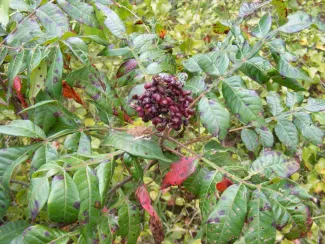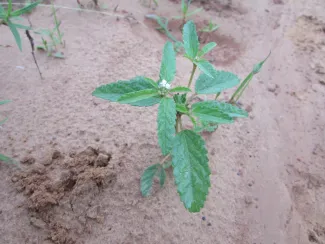
Hunters often rely on acorns, food plots, and corn feeders, but the white-tailed diet includes hundreds of plants and varies across Oklahoma's diverse landscape.
Food plots, crop fields, corn feeders, and acorn-filled oaks may come to mind when envisioning a white-tailed deer’s diet, and deservedly so. But what about poison ivy, ragweed, and plants like prickly pear cactus or mistletoe? Are these eaten too? Knowing a little of what’s preferred – or avoided – by white-tailed deer can help when it comes to making land management decisions.
Oklahoma’s diverse landscape is the first consideration. Specific deer foods present in the Panhandle may not be available in the southeastern corner of the state. Soil type, moisture, and a host of other factors play a role in where plants occur, their abundance, their nutritional qualities, and how they may taste to a deer. However, there are some similarities too.
In short, the average white-tailed diet is heavily weighted toward the stems, buds, and leaves of woody plants, also known as “browse”, as well as herbaceous broad-leaved “weeds,” also known as “forbs.” More than 50% of a deer’s annual diet usually consists of browse and forb foods.
Next in line are fruits, nuts, and berries produced by woody shrubs and trees. These hard and soft “mast” foods are consumed year-round, but a deer’s heaviest use of mast is during the summer and fall months.
Finally, the least-used year-round foods, depending on the region, are grasses and grass-like plants, agricultural crops and food plots, and grain feeds like corn. Despite the abundance of grassy pastures across the state, grasses rarely make up more than 15% of a deer’s annual diet and, in general, the majority of this use occurs during the lean winter and early spring periods. Grasses like bermudagrass are usually avoided unless the competition for food is high or food choices are poor.
It’s important to note that food diversity is extremely important when managing for wildlife, including deer. Some food items are readily eaten during the spring yet avoided the rest of the year while others are eaten year-round. In addition, forbs are the high protein foods that deer seek out, but not all forbs are equal when it comes to protein or other nutritional content. A mixture of habitat types with a diverse mix of plants is often a goal for wildlife managers, especially those managing for deer. Simply, food can be a limiting factor for deer, especially preferred foods, and managing for diversity through strategic burning, grazing, thinning, disking, planting, and, in some cases, habitat restoration can enhance a property for white-tailed deer and other species.
With that in mind, the question may come up as to how diverse a white-tailed diet may be in a given year. Keep in mind, some plants are eaten sparingly while others abundantly. However, regardless of preference, deer food investigations within and near Oklahoma often list 100 to 200 different plants in the diet of a deer in a given locale. The known list of plants eaten by white-tailed deer across the state is much higher, though not every plant occurs in every region.

The new, fresh growth promoted by burning produces tender foliage that is higher in nutritional content, especially protein. Scattered burns throughout the year will create a patchwork of preferred feeding areas that deer and livestock will readily use.
So, which foods are important or preferred by white-tailed deer, other than acorns, corn, and agricultural crops of course! Seasonality can play a major role, but seasons aside, sumacs, elms, dogwoods, and native lespedezas are all readily eaten and important deer foods. In addition, oak browse, coralberry, greenbrier, partridge peas, and crotons are also readily consumed. As mentioned, preferred or important foods vary by season and region and the below table lists many within the state for reference. Remember, regardless of the specific food plants present on a property, each plant’s abundance and availability also plays a role, as does the number of deer and other herbivores pursuing those foods.
The White-tailed Diet
More than 150 choice or preferred deer foods have been documented within the state. This list only provides information on some of the more common plants occurring across Oklahoma. Learn about these plants at wildflower.org or schedule a free visit with a private lands biologist to develop a habitat management plan for your property.
Woody Trees, Shrubs, and Vines | Herbaceous Plants (Forbs) | |||
|---|---|---|---|---|
| PLANT/FOOD | SEASON OF USE | PLANT/FOOD | SEASON OF USE | |
| American Bittersweet | Spring-Fall | Asters | Summer-Fall | |
| American Beautyberry | Summer-Fall | Bladderpods | Year-round | |
| Blackgum | Spring-Fall | Carolina Geranium | Spring-Summer | |
| Blueberries | Spring-Fall | Clovers | Fall-Spring | |
| Box Elder | Spring-Summer | Crotons | Summer | |
| Carolina Snailseed | Spring | Deleas | Spring-Fall | |
| Coralberry/Buckbrush | Summer-Winter | False Daisy/Yerba de Tajo | Summer | |
| Dogwoods | Spring-Summer | Giant Ragweed | Spring-Summer | |
| Elms | Spring-Summer | Horseweed/Mare's Tail | Summer | |
| Greenbriars | Year-round | Lespedezas/Bushclovers | Summer-Fall | |
| Hackberries | Spring-Summer | Medicks | Winter-Spring | |
| Honey Locust (pods) | Fall-Winter | Partridge Peas | Summer | |
| Honeysuckles | Spring-Summer | Pokeweed | Summer | |
| Jersey Teas | Spring-Summer | Pussytoes | Fall-Winter | |
| Leadplant | Spring-Summer | Smartweeds | Summer | |
| Oaks (browse and mast) | Year-round | Sunflowers | Spring-Summer | |
| Osage Orange (leaves) | Spring-Fall | Sweetclovers | Spring-Fall | |
| Persimmon | Summer-Fall | Three-seed Mercuries | Year-round | |
| Plums | Summer-Fall | Ticktrefoils | Summer-Fall | |
| Poison Ivy | Year-round | Vetches | Fall-Spring | |
| Sassafras | Summer | White Avens | Summer-Winter | |
| Spicebush | Summer | Wild Beans | Spring-Summer | |
| Sumacs | Year-round | Winecup | Fall-Spring | |
| Wild Grapes | Spring-Summer | Wingstem/Crownbeard | Spring, Fall | |
| Wild Roses | Summer | Wood Sorrels | Summer-Fall |

Sumacs are on the white-tailed diet year-round, but are often targeted for brush control. For management purposes, thickets that are 50-foot in diameter are optimum for deer, quail, and other wildlife.

Crotons are choice summer deer foods that are promoted through light winter disking. Sometimes referred to as doveweeds, these plants are also of high value to dove, quail and many other seed-eating birds.
Overall, the white-tailed diet is adaptable; choice foods are eaten first when available and medium and low preference foods are switched to if needed. However, the prevalence of suboptimal foods on a property can push deer to find preferred foods elsewhere or, ultimately, potentially lead to a decrease in herd health. This is why habitat quality and plant diversity are so important, with each providing the day-to-day and month-to-month cover and food requirements that deer require and eagerly seek. Management, too, plays a key role, with monitoring and managing deer numbers similar in importance to sound habitat management depending on specific landowner goals.